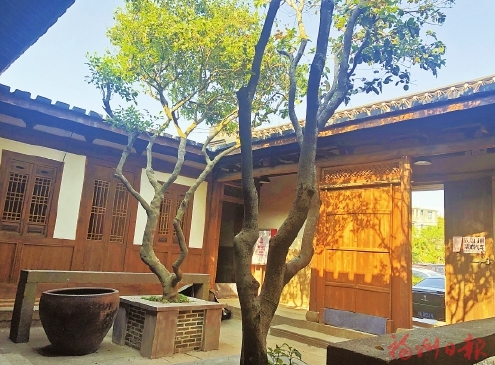Restoration of the Former Residence of Yan Fu in Yangqi Completed
2020-05-03 10:23:55
Reported by Wu Hui
2020.05.03
May 3, 2020

Restoration of the former residence of Yan Fu is completed. Photographed by Wu Hui (Fuzhou Daily)
FUZHOU, May 3 (Fuzhou Daily) – Yangqi Village in Gaishan Town of Cangshan District was the hometown of Yan Fu, a renowned modern Chinese thinker of the late 19th century. Yan Fu’s residence and tomb are both listed as major monuments protected at the national level.
As a key project of the new round of protection and upgrading of “gucuo” (ancient houses) in Fuzhou, the restoration of the former residence of Yan Fu in Yangqi has been completed recently. On May 1, our reporter visited the former residence of Yan Fu together with Qiu Shoulian, an expert on ancient architecture, and listened to the stories behind the restoration.
The black-gray courtyard wall is exquisitely built.
At Yan Fu’s former residence, the reporter saw a building of Qing Dynasty with column and tie construction built by wood, covering an area of over 700 square meters. It is an ancient house with two gates and three bays, composed of front and rear halls, left and right wing rooms, front and rear patios, left and right pavilions, and porches.
Before entering the former residence, the reporter noticed that the black-gray courtyard walls of the residence were different from the white ones of many Fuzhou “gucuo”. Is there anything special?
Qiu Shoulian said that to paint the walls black and gray is not only a tradition of Fuzhou “gucuo” but also and a symbol of the owners’ social status. Because Yan Huaiying, ancestor of Yan’s family in Fujian, was a Grand Master for Court Audience during the Tang Dynasty, Yan Fu’s former residence was also called “Residence of Grand Master”.
“Such walls are painted with black soot, and the manufacturing process is very complicated,” said Qiu Shoulian. The black soot is what formed on the bottom of pots after the firewood is burned. “ The walls painted can be kept for a hundred or two hundred years without fading or flaking when the black soot is mixed with rice vinegar, rice wine and other materials. In such a rainy city as Fuzhou, the black-soot paint on the wall can also be moisture-proof. Moreover, painting the wall black can reduce the light reflection so that the eyes will not be irritated.
Floral pattern tiles are preserved.
Above the wall of the former residence, the reporter saw a row of hollowed-out floral-pattern tiles. Qiu Shoulian said, “Although the former residence of Yan Fu in Yangqi was built in the Qing Dynasty, traces of various periods from the Qing Dynasty to the present could be found here. We referred to the historical data and photos and found this row of floral pattern tiles above the courtyard wall was built during the Republic of China era.”
According to Qiu, the hollowed-out floral pattern tiles are not only decorative but also windproof.
In the interview, Qiu Shoulian said that in the design of this renovation plan, this row of floral pattern tiles was originally planned to be demolished, but many experts of ancient architecture insisted on preserving it. “The floral pattern tiles were damaged before the repair, but ‘retaining the original state of monuments’ is the principle we follow in the restoration of ancient houses. Therefore, the floral pattern tiles were preserved and repaired,” said Qiu Shoulian.
“Taotie” will be changed to “grass dragon”.
“This wooden relief looks like a ‘Taotie’, a mythical ferocious animal and one of the nine sons of the Chinese dragon, which does not meet the ancient architectural arrangement, so we recommended changing it to a ‘grass dragon’”, when stepping into the front patio in front of the second gate of the former residence, Qiu Shoulian stopped and said.
Ancient Chinese craftsmen were very good at applying paintings, carvings and other art forms to architecture, and this is also true of the building of the former residence. Due to disrepair, the timber components of the residence were rotten to varying degrees and the original wooden relief has been damaged. Therefore, in this restoration, a “Taotie” relief was carved.
Qiu Shoulian said that “Taotie” is an ancient legendary beast with big eyes on the wide face and double horns on the head. Looking like a cow but not a cow, and like a tiger but not a tiger, it is an animal image combining features of various animals. Since Taotie loves eating, people today refer to those who are knowledgeable about food as “Tao”. Qiu Shoulian said, “In ancient times, the image of ‘Taotie’ was generally carved on sacrificial offerings and it was rarely used as a building decoration, so we recommended changing it to a common ‘grass dragon’ image.”